Cigars may be described using several core flavors. Most of the flavors are similar to those used to characterize wine because cigars and wine share a lot in common. The core cigar descriptors include plants, spices and herbs, earth and minerals, fruits, nuts, and flowers.

(Freeimages / Gareth Peters)
Included in the plant flavors are grass, hay, moss, tea, and wood. Yes, wood. Wood is an important part of the taste package of a cigar because it is a highly recognizable flavor. The essence of wood tends to lead out in the overall flavor of a cigar and be a key distinguishing factor between different sticks.
The wood flavor is easily detected in mild cigars that are wrapped in Connecticut shade leaves. The flavor may also come from the type of wood used in making the humidor where the cigars are kept. The wood flavor is divided into sub-categories such as cedar, oak, and smoked wood.
Cedar is the most common wood taste in cigars. A lot of cigars are cedar-aged or kept in cedar humidors or cabinets. The cedar flavor often influences the cigar after the fermentation and aging of the leaves. Adding cedar flavor to your cigars is simple. If you have a cedar cabinet, set your humidor in the cabinet and let the cigars settle, age, and soak up the flavor.
Oak flavor can also be found in cigars, though it is less common than cedar. The oak flavor is tougher to achieve and involves putting your cigar through a rigorous cask aging process. While some types of tobacco possess a natural oak essence, aging your cigars in an oak cask will ensure the type of woody taste and aroma that you want. The oak flavor of a cigar is similar to the tannic qualities in wines. It is often accompanied by a dry sensation on the smoker’s palate.
The smoky wood flavor is associated with mesquite and hickory wood. Smoked wood cigars are rare, but the hunt is often well worth it.
The next time you smoke a cigar, note the essence of wood. Over time, you will get to know which wood flavors are more appealing to you, and that can help you narrow down your cigar choices.




